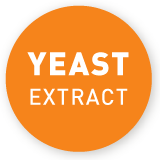Frequently asked questions about yeast extract
Most people living in the UK or Australia will have heard about yeast extract already – it is popular to use it as a spread on sandwiches and toast. In other European countries people do not have a clear understanding of yeast extract – what yeast extract is, its health benefits and how it is used in cooking. We have answered the most frequently asked questions below.
Yeasts are truly a natural all-rounder and essential for the production of common foods. They occur in nature as wild yeasts everywhere and are bred as culture yeasts with specific properties. Fresh yeast has been used for thousands of years to make bread and beer and is also essential for making wine. Yeast extract is also made from fresh yeast. Enzymes break down the proteins that are present in the yeast cell into smaller components and disintegrate the cell wall so that the content dissolves out of the cell. The remaining cell walls are removed by centrifugation. In simple terms, yeast extract is made up of proteins, amino acids, carbohydrates, vitamins and minerals from the yeast cell without the surrounding cell wall.
Yeast extract is a natural ingredient composed of a variety of amino acids, carbohydrates, vitamins and minerals and is rich in high-quality proteins. Its base fresh yeast provides a rich blend of natural components. Although yeast extract is not made up of any animal ingredients, the taste is similar to that of a meat bouillon. This is because many of the same taste giving amino acids are present in both yeast extract and meat bouillons.
Yeast extract has been used as an ingredient in food products for approximately the past 75 years. However, the basic ingredient for yeast extract, fresh yeast, has been used for thousands of years to make bread and beer. Combining ingredients and influencing taste is what cooking is all about. Yeast extract not only adds taste, but also brings out and balances flavours in products, just like herbs and spices do. That’s why today, yeast extract is a very popular ingredient in food production and food manufacturing.
Yes. Even though it provides a meaty taste to food, yeast extract does not contain ingredients from animal origin and is therefore suitable for vegetarian and vegan dishes. Read more …
Currently in the EU, manufacturers do not need to stipulate whether or not their yeast extract is made from baker’s or brewer’s yeast, so the safest way to check if your yeast extract product is suitable is check for the sign ‘coeliac safe’.
Yeast extract contains around 65% of protein. Its origin, natural yeast, is composed of a rich mix of proteins and amino acids that are also found in yeast extract.
Nutritional yeast is sold as powder or flakes and adds a savoury, cheesy flavouring to recipes. Both nutritional yeast and yeast extract have an umami taste.
Many fresh products naturally contain glutamic acid, including tomatoes, peas and mushrooms. Our body also produces glutamate, regardless of the food we consume. Indeed, it is naturally present in saliva and breast milk. It is also one of the many natural components of yeast extract.
In comparison with other foods we consume daily – including tomatoes, mushrooms and cheese – the glutamic acid level of yeast extract is therefore very low. For instance, one tomato contains on average approximately twice the amount of glutamic acid present in 200ml of yeast extract flavoured bouillon.
Yeast extract, used with a primary function of flavouring in foods, can be labelled as “yeast extract” or “natural flavouring” in the list of ingredients. If yeast extract is added to food for nutritional purposes, then “yeast extract” is a generally accepted customary name that can be included in the list of ingredients. Read more on food labelling.




